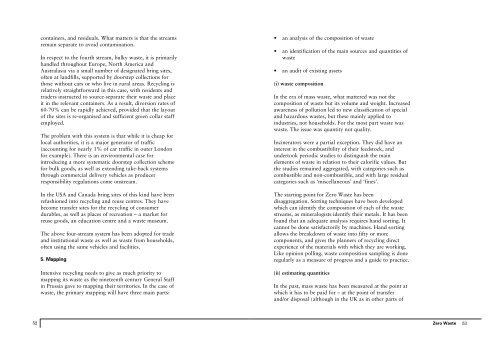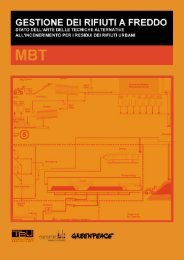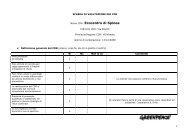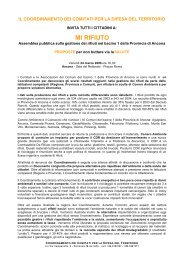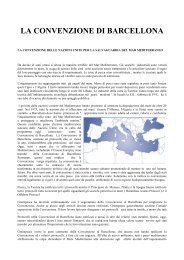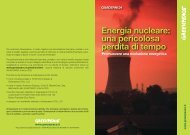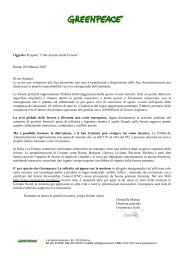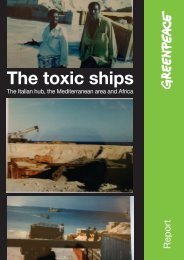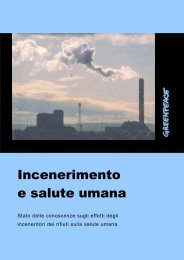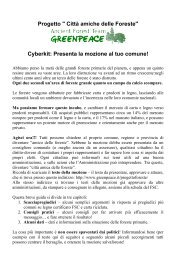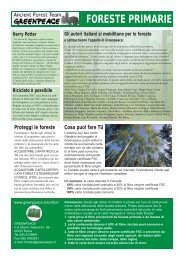Zero Waste by Robin Murray, Greenpeace Environmental Trust 2002
Zero Waste by Robin Murray, Greenpeace Environmental Trust 2002
Zero Waste by Robin Murray, Greenpeace Environmental Trust 2002
Create successful ePaper yourself
Turn your PDF publications into a flip-book with our unique Google optimized e-Paper software.
containers, and residuals. What matters is that the streams<br />
remain separate to avoid contamination.<br />
In respect to the fourth stream, bulky waste, it is primarily<br />
handled throughout Europe, North America and<br />
Australasia via a small number of designated bring sites,<br />
often at landfills, supported <strong>by</strong> doorstep collections for<br />
those without cars or who live in rural areas. Recycling is<br />
relatively straightforward in this case, with residents and<br />
traders instructed to source-separate their waste and place<br />
it in the relevant containers. As a result, diversion rates of<br />
60-70% can be rapidly achieved, provided that the layout<br />
of the sites is re-organised and sufficient green collar staff<br />
employed.<br />
The problem with this system is that while it is cheap for<br />
local authorities, it is a major generator of traffic<br />
(accounting for nearly 1% of car traffic in outer London<br />
for example). There is an environmental case for<br />
introducing a more systematic doorstep collection scheme<br />
for bulk goods, as well as extending take-back systems<br />
through commercial delivery vehicles as producer<br />
responsibility regulations come onstream.<br />
In the USA and Canada bring sites of this kind have been<br />
refashioned into recycling and reuse centres. They have<br />
become transfer sites for the recycling of consumer<br />
durables, as well as places of recreation – a market for<br />
reuse goods, an education centre and a waste museum.<br />
The above four-stream system has been adopted for trade<br />
and institutional waste as well as waste from households,<br />
often using the same vehicles and facilities.<br />
5. Mapping<br />
Intensive recycling needs to give as much priority to<br />
mapping its waste as the nineteenth century General Staff<br />
in Prussia gave to mapping their territories. In the case of<br />
waste, the primary mapping will have three main parts:<br />
• an analysis of the composition of waste<br />
• an identification of the main sources and quantities of<br />
waste<br />
• an audit of existing assets<br />
(i) waste composition<br />
In the era of mass waste, what mattered was not the<br />
composition of waste but its volume and weight. Increased<br />
awareness of pollution led to new classification of special<br />
and hazardous wastes, but these mainly applied to<br />
industries, not households. For the most part waste was<br />
waste. The issue was quantity not quality.<br />
Incinerators were a partial exception. They did have an<br />
interest in the combustibility of their feedstock, and<br />
undertook periodic studies to distinguish the main<br />
elements of waste in relation to their calorific values. But<br />
the studies remained aggregated, with categories such as<br />
combustible and non-combustible, and with large residual<br />
categories such as ‘miscellaneous’ and ‘fines’.<br />
The starting point for <strong>Zero</strong> <strong>Waste</strong> has been<br />
disaggregation. Sorting techniques have been developed<br />
which can identify the composition of each of the waste<br />
streams, as mineralogists identify their metals. It has been<br />
found that an adequate analysis requires hand sorting. It<br />
cannot be done satisfactorily <strong>by</strong> machines. Hand sorting<br />
allows the breakdown of waste into fifty or more<br />
components, and gives the planners of recycling direct<br />
experience of the materials with which they are working.<br />
Like opinion polling, waste composition sampling is done<br />
regularly as a measure of progress and a guide to practice.<br />
(ii) estimating quantities<br />
In the past, mass waste has been measured at the point at<br />
which it has to be paid for – at the point of transfer<br />
and/or disposal (although in the UK as in other parts of<br />
52<br />
<strong>Zero</strong> <strong>Waste</strong><br />
53


